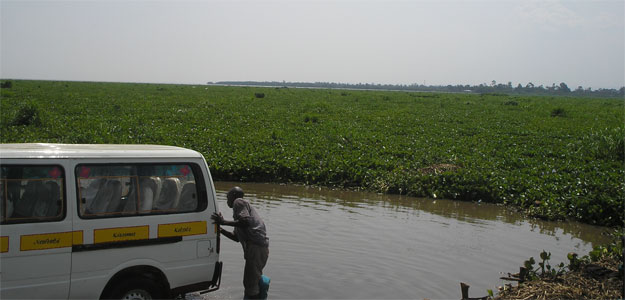
Green Waves on Lake Victoria
 Three African nations share responsibility for Lake Victoria, the world's second largest freshwater lake. Nonetheless, the
spread of an unexpected invasive plant might prove to be their biggest environmental challenge yet. Can three national governments
cooperate to meet the green wave? (Photo by Abisalom Omolo)
Three African nations share responsibility for Lake Victoria, the world's second largest freshwater lake. Nonetheless, the
spread of an unexpected invasive plant might prove to be their biggest environmental challenge yet. Can three national governments
cooperate to meet the green wave? (Photo by Abisalom Omolo)
By Abisalom Omolo
Once a clear freshwater source, once a source of livelihood to millions of fishermen, once a point of cross-border business for Kenya, Uganda and Tanzania, Lake Victoria, the source of the White Nile, is choking under an infestation of water hyacinth.
Recent aerial views of the lake reveal dots of open water amid a sea of green, an infestation of plant matter that has turned much of the water to a soupy brown color. Fishermen in Lake Victoria have lost their source of income with the weed taking away much of the catch. Amos Obuya, a 50 year old fisherman who has worked the lake for over 20 years, no longer fishes at the lake but instead relies on catching much less at nearby Dunga beach. "I have fished in this lake for a long time but the water hyacinth has made me a beggar. I've lost my nets and even the catch went down."
The weed has gradually become a fisherman's nightmare over the past 20 years, as the three national governments sharing the water source have left the fishermen to battle it themselves. The water hyacinth originally invaded the lake through the Kagera river in Uganda, quickly multiplying and forming thick mats of vegetation that chokes the life beneath it. In Kenya, the Luo community that relied on the lake as a fishing ground has been transformed into farmers.
Experts believe heavy silt levels and constant industrial pollution have contributed greatly to the state of the lake. Dr. Goedfrey Ogonda, a conservationist with Osienala, an organization responsible for Lake Victoria for the last 15 years, has seen the lake change from bad to worse. "Nutrient rich soil deposited into the lake has contributed to the proliferation of algae and weeds such as the hyacinth. If industries continue to release their effluent into the water, they will see the end of the lake."
Official statistics indicate that at least three million tons of topsoil is deposited into the water mass each year from run-off in the Nyando basin alone. As a result, fish stocks have gone down in the lake and fishermen have either resorted to alternative means of making a living or have been forced to make do with small catches. As silt continues to clog the lake and make ideal conditions for the spread of invasive plants like the hyacinth, the fishing industry of the three east African countries that share the lake continues to suffer.
While the Ugandan government has devised a method of manually removing the weed from the lake, Kenyans in the Winam Gulf, especially the population centers of Sango Rota, Homa Bay, and Kisumu city have continued counting their losses. Concern is now brewing over the introduction of several new species of weeds, such as hippo-grass and papyrus weed. Experts are concerned that the introduction of new species of weeds is a good indication that excess nutrients continue to flow into the lake through runoff. If runoff continues, the biomass on the lake will eventually overwhelm the lake itself as it decays. "Plant succession is the process by which stronger plants take advantage of the presence of another plant to invade a habitat. The hippo grass that has invaded the lake does not normally inhabit an open lake ecosystem ,and are instead dominant in shallow river basins and swamps," Dr Ogonda explains.
The spread of the hyacinth has also hampered transport on Lake Victoria, particularly on the Kenyan side. Carried by night tides, the weed continually clogs harbors and blocks boats which have docked. More success has been found on the opposite side. Uganda has undertaken a US$13.9 million project to manually remove the weed which has freed up the beaches around Kampala and Port Bell to allow boats to maneuver.
Nonetheless, if the three East African countries that share Lake Victoria don't confront the water hyacinth dilemma as a group, Lake Victoria's status as the second largest freshwater lake in the world may be in danger of a green wave.
Abisalom Omolo is a columnist with the Lake Victoria Journal and a radio journalist for Radio Lake Victoria.
